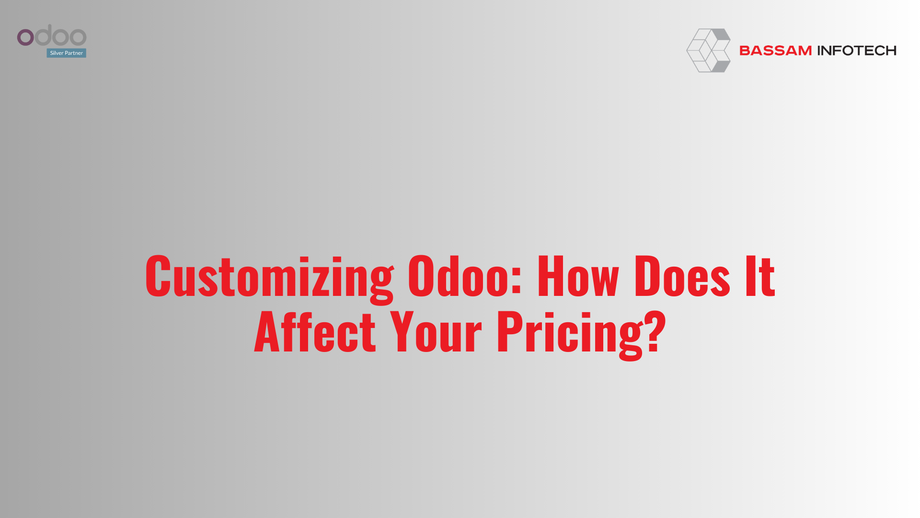Odoo is one of the most versatile and flexible ERP systems available, known for its ability to adapt to various business needs. However, as with any robust software platform, customization comes with its own set of costs and considerations. Understanding how customizing Odoo affects your pricing is crucial to making informed decisions that align with your business goals and budget.
1. Understanding the Base Costs
Before diving into customization, it’s important to grasp the base costs of implementing Odoo. Odoo offers different pricing tiers depending on the version you choose—Odoo Community (free but with limited features) or Odoo Enterprise (paid with extensive features and support). The Enterprise version has a subscription fee that varies depending on the number of users and the modules you select. These base costs form the foundation of your Odoo investment, and any customization will add to this base price.
2. Types of Customization and Their Costs
Customizing Odoo can range from simple adjustments to complex modifications. The type of customization you require significantly impacts the overall pricing:
-
Module Customization: Customizing existing Odoo modules to better fit your business processes is one of the most common forms of customization. Depending on the complexity, this can involve anything from modifying forms and fields to adjusting workflows or creating custom reports. The cost will vary based on the extent of these changes.
-
New Module Development: If your business needs to go beyond what the existing Odoo modules offer, you might require the development of new modules. This level of customization involves significant time and expertise, making it more costly. Additionally, the maintenance of these custom modules will add to the long-term costs.
-
Integration with Other Systems: Many businesses need Odoo to integrate with other software systems, such as CRMs, accounting tools, or industry-specific applications. Integrations can be complex and often require custom development, which adds to the initial implementation costs as well as ongoing support and maintenance expenses.
-
User Interface (UI) Customization: Tailoring the Odoo user interface to meet your brand’s requirements or to improve user experience can also affect pricing. This could include changing themes, and layouts, or adding custom dashboards.
3. Factors Influencing Customization Costs
Several factors can influence the cost of customizing Odoo:
-
Complexity: The more complex the customization, the higher the cost. Complex customizations require more time and advanced technical skills, which can drive up both the development and maintenance expenses.
-
Time and Resources: The duration of the customization project and the resources required will directly impact costs. Projects that require extensive testing, debugging, and iteration tend to be more expensive.
-
Provider Expertise: The cost will also depend on the expertise of the Odoo partner or developer you choose. Experienced developers might charge more but often deliver higher quality and more efficient solutions, potentially saving money in the long run.
4. Long-Term Costs and Maintenance
Customization isn’t a one-time cost. Once your Odoo system is customized, there will be ongoing costs for maintenance, updates, and support. As Odoo releases new versions, customizations may need to be updated to remain compatible, which can incur additional costs. It’s essential to budget for these long-term expenses when planning your customization.
5. Balancing Customization with Budget
While customization can significantly enhance the functionality of Odoo to better suit your business needs, it’s important to balance these benefits with the associated costs. Here are a few tips:
-
Prioritize Essential Customizations: Focus on customizations that deliver the most value to your business. Start with essential changes and consider additional customization as your budget allows.
-
Choose the Right Odoo Partner: Work with an experienced Odoo partner who can provide a clear understanding of costs and help you make informed decisions. They can offer insights into how to achieve your goals within your budget.
-
Consider Phased Implementation: Instead of customizing everything at once, consider a phased approach where you implement core customizations first and add more over time as needed and as budget permits.
Customizing Odoo offers tremendous potential to tailor the system to your specific business needs, but it’s essential to understand how these customizations impact your overall pricing. By carefully planning your customization strategy, choosing the right partner, and budgeting for long-term maintenance, you can maximize the benefits of Odoo while managing costs effectively. Ultimately, a well-customized Odoo implementation can provide a significant return on investment by enhancing productivity, streamlining processes, and supporting business growth.

